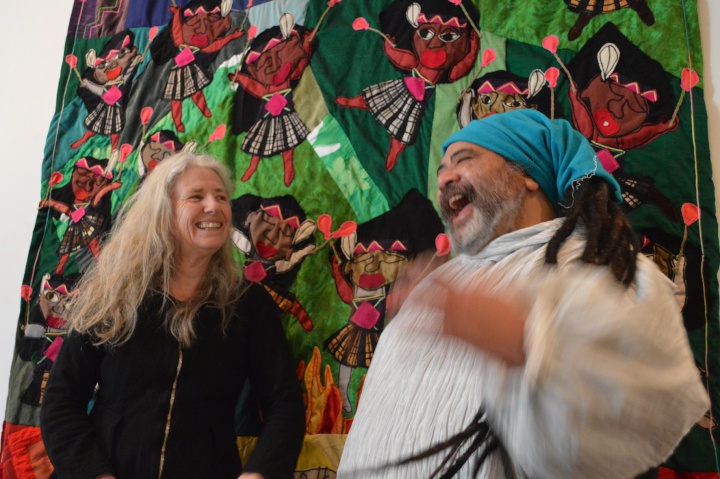Matariki programme harnesses art’s capacity to heal
Friday 21 June, 2019
Matariki
programme harnesses art’s capacity to heal and
renew

ACE Maori Educator of the Year Ron Te Kawa (right) and Mahara Gallery Director Janet Bayly (left) in front of Ron’s Welcome Home We Love You quilt which will be a feature of the Gallery's 2019 Matariki exhibition.
Terror in Christchurch and concern about climate change have been the motivation for the 2019 Mahara Gallery Matariki programme which seeks to harness art’s capacity to support emotional healing and renewal.
The Gallery’s Matariki exhibition opens on Saturday 22 June and is supported by a programme of 10 workshops or events in late June and July.
“Matariki is the time for remembering those we have lost, for reconnecting as a community, and celebrating rebirth and renewal,” says Gallery Director, Janet Bayly.
“The year has so far delivered events that have been confronting in the case of the Christchurch massacre and challenging in the case of the climate change marches.
“In putting together a programme for Matariki, we looked for a way to harness art’s capacity to support emotional healing and renewal.”
Janet Bayly says thirteen artists will be exhibiting in the gallery and some will be involved in the 10 workshops or events during June and July in which the community is invited to participate.
The exhibiting artists include Pania Barrett, Danielle Burns, Di Connal, John Foster, Kath Foster, Kate Hartmann, Ramila Parbhu, Robyn Kahukiwa, Maungarongo Te Kawa, Colin McCahon, JoAnne Mere, Tracey Morgan and Yvonne de Mille.
“Many of the artists who responded to our invitation told us about their reaction to what happened in Christchurch and the effect that it’s had on their work,” says Janet Bayly.
“Otaki artist Ramila Parbhu, who uses recycled materials to create her works, told us that the Christchurch shootings had left her with ‘an overwhelming sense of sadness’ and that art is her form of healing and grounding in the world.
“We are thrilled to have a quilt from the wonderful Woodville-based fabric artist, Ron Te Kawa. Ron’s quilts all tell a story and there’s always a connection with the past because his ancestors are never far from him.
“Ron was recently honoured as ACE Maori Educator of the Year. We are thrilled that as well as exhibiting his work, he will run workshops on 10 and 11 July during which participants will create a Matariki bird using fabrics.”
Janet Bayly says the Gallery is honoured to have been offered a 1959 Colin McCahon landscape as part of the exhibition.
“It’s an example of the concern McCahon felt about environmental degradation. McCahon was in a distinct minority at that time, but when we fast forward to today with its very pressing concern for the environment, we can see just how far-sighted he was.”
Another of the features of the Matariki programme will be workshops run by Otaki artist, Yvonne de Mille, widely known for her work in kite and lantern making. She will run lantern-making workshops in the Gallery on 25 June and 2 July.
She will also run a workshop which involves painting a tree through the seasons on 27 June.
“Yvonne’s kites and lanterns have been a popular part of Matariki exhibitions in the past. It’s great that she has been able to be a key figure in our programme and artist in residence this year.”
One of the more unusual exhibitors is Kath Foster of Paraparaumu who re-shapes domestic furniture such as tables.
She was born and grew up in North Auckland, the daughter of artist parents. Work by her mural painter father John, who was taught in Auckland by Colin McCahon, is also included in the exhibition.
ends


 Gordon Campbell: On The Looming Conflicts Within The Trump Presidency
Gordon Campbell: On The Looming Conflicts Within The Trump Presidency New Zealand Customs Service: Customs Celebrates Successes On International Customs Day
New Zealand Customs Service: Customs Celebrates Successes On International Customs Day Imperial Brands: Seizures Of Black Market Tobacco Show Strong Policy Action Needed From Government
Imperial Brands: Seizures Of Black Market Tobacco Show Strong Policy Action Needed From Government PSA: Axing Of Callaghan Innovation, Loss Of 500 Jobs Already Makes Mockery Of Latest Reform
PSA: Axing Of Callaghan Innovation, Loss Of 500 Jobs Already Makes Mockery Of Latest Reform NZCTU: Working People Will Pay For Static Inflation
NZCTU: Working People Will Pay For Static Inflation ACT New Zealand: Too Early For A Victory Lap, But Hope Is On Its Way
ACT New Zealand: Too Early For A Victory Lap, But Hope Is On Its Way Greenpeace New Zealand: Trump Exit From Paris Agreement Means NZ Must Rally With World To Save Climate
Greenpeace New Zealand: Trump Exit From Paris Agreement Means NZ Must Rally With World To Save Climate


